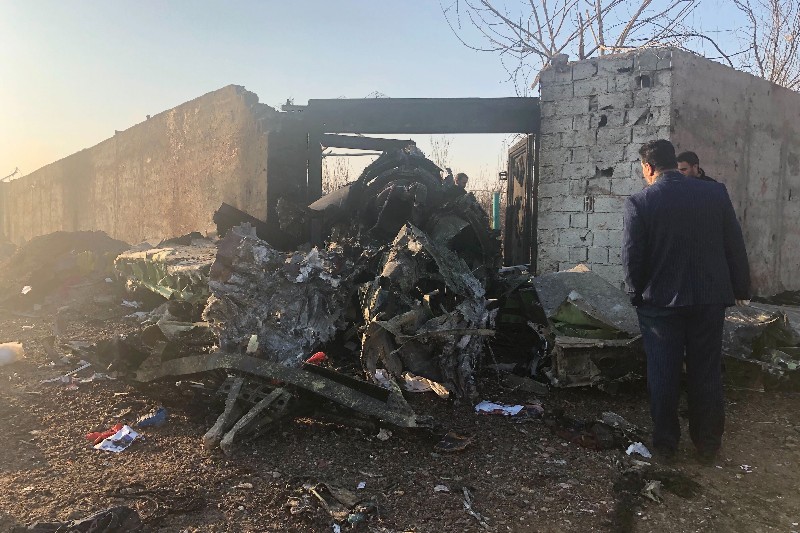A Ukrainian passenger plane carrying at least 170 people has crashed minutes after takeoff near the Iranian capital of Tehran. Iranian state media reported that the Kiev-bound Ukrainian International Airlines flight PS752 crashed near just three minutes after takeoff from Imam Khomeini International Airport, killing all on board.
Ali Kashani, a spokesman for Imam Khomeini International Airport, told Fars news agency: ‘It is predicted that technical problems caused the accident.’ But video footage tweeted by the BBC’s Iran correspondent, Ali Hashem, appeared to show the plane already burning in the sky before it crashed in a massive explosion, sparking speculation that the jet had been shot down.
Flight data shows the three-year-old Boeing 737-800 reached an altitude of 7,925ft and then suddenly disappeared. Tracking of the flight ended after six minutes and it was moving at a ground speed of 316 miles-per-hour. Photos later published by Iran’s state-run IRNA news agency showed rescue officials in a farm field, with what appeared to be pieces of the aircraft laying nearby.
The plane ‘crashed around Parand’, about 60 kilometres south-west of the Iranian capital, state media said. An investigation team was at the site of the crash in southwestern outskirts of Tehran, Iran’s civil aviation spokesman Reza Jafarzadeh told the Associated Press. ‘After taking off from Imam Khomeini international airport it crashed between Parand and Shahriar,’ Jafarzadeh said.
‘An investigation team from the national aviation department was dispatched to the location after the news was announced.’ Horror pictures from the scene of the crash show scattered and charred wreckage littering the ground. Pirhossein Koulivand, head of Iran’s emergency services, had told State TV that they hoped to rescue survivors at the scene.
But later said: ‘The fire is so heavy that we cannot (do) any rescue… we have 22 ambulances, four bus ambulances and a helicopter at the site.’ The crash came hours after Iran launched a ballistic missile attack targeting two bases in Iraq housing U.S. forces. It was Iran’s most direct assault on America since the 1979 seizing of the U.S. Embassy in Tehran.
The retaliation for the killing of Revolutionary Guard Gen. Qassem Soleimani came after president Trump approved the drone strike that killed the general shortly after he arrived in Baghdad, Iraq. Iran fired more than a dozen ballistic missiles at two Iraqi bases housing American troops on Tuesday night, hours before the Ukrainian plane crashed. The Ain al-Asad airbase in western Iraq that Trump visited in December 2018 and the Erbil base in Iraqi Kurdistan were both struck by the missiles on Tuesday at about 5.30pm (EST), but no casualties were reported.
Iran’s Revolutionary Guards, which controls the country’s missile program, confirmed that they fired the rockets just hours after the slain general’s funeral, and reported the operation’s name was ‘Martyr Soleimani’.
Trump and his advisers are under pressure to disclose more details about the intelligence that led to the U.S. strike on Soleimani. The Ukrainian airlines jet which crashed was a Boeing 737-800 – a very common single-aisle, twin-engine jetliner used for short to medium-range flights.
Thousands of the planes are used by airlines around the world. Introduced in the late 1990s, it is an older model than the Boeing 737 MAX, which has been grounded for nearly 10 months following two deadly crashes. A number of 737-800 aircraft have been involved in deadly accidents over the years.
In March 2016, a Flydubai 737-800 from Dubai crashed while trying to land at Rostov-on-Don airport in Russia, killing 62 onboard. Another 737-800 flight from Dubai, operated by Air India Express, crashed in May 2010 while trying to land in Mangalore, India, killing more than 150 onboard. ‘We are aware of the media reports out of Iran and we are gathering more information,”
Gordon Johndroe, spokesperson for Chicago-based Boeing Co. said in a statement. Boeing, like other airline manufacturers, typically assists in crash investigations. However, that effort in this case could be affected by the U.S. sanctions campaign in place on Iran since President Donald Trump unilaterally withdrew from Tehran’s nuclear deal with world powers in May 2018.
Both Airbus and Boeing had been in line to sell billions of dollars of aircraft to Iran over the deal, which saw Tehran limit its enrichment of uranium in exchange for the lifting of economic sanctions. But Trump’s decision halted the sales.


